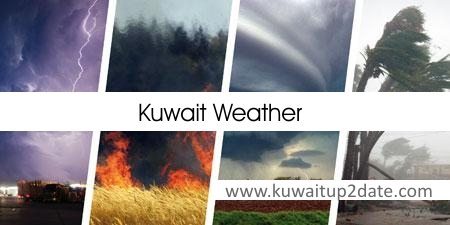Weather
Summer (21 May – 4 November)
Great increase in humidity and temperature.
Transition period (21 May – 5 June)
Winds are characterized by unstable directions as they swing between south east, north west and south east, light to moderate. This period is the transition period between the late spring and the real summer and the maximum temperature ranges between 40° and 44° centigrade and sky is usually clear of clouds.
Dry summer (6 June – 19 July)
Period of Semoom winds and dust storms.
Summer fortieth (6 June – 15 July)
Barih Al-Jawzaa or Great Barih (3 July – 15 July)
This period is predominated by hot ad dry north westerly wind (Semoom) and they may be continuous as they are not often interrupted by winds coming form other directions. These winds vary in their speed between strength and weakness. These winds become active in some periods which lead to the occurrence of strong dust storms where the visibility may decrease to few meters especially at noon. The dust storms tend to occur during four main periods: from 9 – 12, 17 – 24 June, 1 – 7 and 9 – 17 July when the north westerly winds intensify during these periods and they reach their peak during the day then they became calm gradually during the night then they become active again in the following day. The average maximum temperature ranges between 42° and 46° centigrade.. Clouds disappear completely from the sky and the wet southerly winds rarely blow.
Wet summer (20 July – 4 November)
Great increase in humidity and temperature.
Second Jawzaa (16 – 28 July)
Summer Bahura (23 – 30 July)
Al-Marzam (29 July – 10 August)
Al-Kulaibin (11 – 23 August)
The wet periods begin mostly in 20th July and they may continue irregularly during August and October. During these periods, the light easterly and southeast winds dominate and they may be moderate at noon. Because of the winds flow over the Gulf, they are loaded with huge amounts of water vapor and because the temperature is high during this season, they are exhausting greatly especially when accompanied by wind stillness. In some periods, the winds are north westerly till noon then they change as a result of sea breeze to north easterly then to northerly only till afternoon then south easterly till sunset then southerly till midnight then westerly till sunrise. The length of the wet period ranges between two days and twenty continuous days especially during the periods from 18 – 29 July and form 6 – 19 August. Some clouds may appear during these periods and thunder- rain are probable though rare. The average maximum temperature ranges from 45° and 46° centigrade. While the maximum temperature recording at Kuwait Int’l Airport was 51.3° centigrade in 20 Aug. 1998
Transition period (1 September – 4 November)
Drop in Temperature –continuous humidity – Calm wind.
The wet periods continue to dominate during this period especially during the periods from 15 – 29 September and from 12 – 26 October. The Semoom winds disappear and the heat severity decreases and the temperature begin to decrease quickly after 11 September. The maximum temperature ranges between 42° centigrade in the beginning of the period and 30° centigrade at its end. The sea and land breezes occur much during this period and the clouds begin to increase. It is noted that the weather is exhausting summer if the winds are humid south easterly whereas the weather becomes refreshing autumn if the winds are north westerly.
Autumn (5 November – 5 December)
Moderate temperature – clouds and rain – cold night.
The hot season usually ends in 5 November as this date is preceded by wet and hot south easterly wind which changes afterwards to cold north westerly wind. It may be accompanied by thunder storms and the average maximum temperature ranges between 20° and 30° centigrade. It is noted that nights are usually cold while daytimes are warm. The warm south easterly winds blow during this period and it may last for a week especially in the beginning of November then it is followed by cold north westerly winds that last for five days and cause the clouds to disappear then they change again to warm south easterly winds for four days approximately accompanied by increase in clouds which may be thunderous at sometimes. The wind in this period is often calm especially during night.
Winter (6 December – 15 February)
Great decrease in temperature – clouds and rain – very cold North westerly Wind.
Murba’ania (6 Dec – 15 Jan)
Weather is cold – very cold especially during night or when the dry cold north westerly wind are very strong (maximum temperature is 13° centigrade and it may decrease to 3.3° centigrade) except for warm intervals resulting from the blowing of wet south easterly wind (maximum temperature is 23° centigrade and it may increase to 31.3° centigrade).
Mild Winter (16 Jan – 15 Feb)
Sky begins to overcast and the rain start to fall after the flow of the south easterly wind which may be strong in some cases and this leads to occurrence of dust storms. After the south easterly wind, very cold north westerly wind blow especially during January. The temperature reaches sometimes below zero centigrade which leads to freeze (frost). The minimum temperature during the season reached – 4° centigrade in 20th January 1964 in Kuwait International Airport. Fog sometimes occurs especially in quite nights. This period is dominated by the blow of cold north westerly wind.
Spring (16 February – 20 May)
Moderate temperature variable temperature – rain and thunder clouds – hot southerly wind.
Cold moderate spring (16 February – 8 April)
Al-Ajouz (26 February – 8 March)
Al-Suhily (15 March – 10 April)
Temperature begins to increase apparently after 16 February after being stable on the winter averages and the severity of cold breaks. The hot south (Al-Suhily) wind blow during the period from 15 March – 10 April and it lasts for several days and the maximum temperature may reach 41° centigrade (13° centigrade above the average) which misleads summer but the moderate cold westerly wind blow in this time to reduce temperature notably. This period is dominated by the flow of easterly and south easterly wind especially during daytime. There are many occurrences of thunder storms especially during the period from 10 March to 8 April and it is sometimes accompanied by severe dust storms where the visibility drops to zero. The dangerous of these storms increases by their fast developments and unexpected occurrence to the extent that it is difficult for the offshore boats to avoid them as the average speed of these storms is 65 kilometer per hour. It is noted that the air following the thunder storm is very cold (12 centigrade less than the air mass directly before it).
Warm spring (9 April – 20 May)
Al-Sarayat (9 April – 13 May)
This is the season of Al-Sarayat (local thunder storms). Thunder clouds are usually develops in the afternoon or during night accompanied by severe dust storms where the visibility may drops to zero during these storms and heavy rainfall within few minutes (the heaviest rainfall during this period dated 4th of April 1976 and it reached 38.4 mm within 20 minutes). The south easterly wind during this period is wet and hot. Temperature is changeable from one day to another especially during the period from 11 – 30 April as it increases to the summer rate for few days then it decreases to a noticeable degree after the blow of the north westerly winds to a notable degree. It is common during the month of May that winds are south westerly in the morning changing to easterly winds in the afternoon due to the sea breeze. Temperature begins to gradually increase as the average temperature ranges between 30° centigrade in the beginning of the period and 40° centigrade at its end.







In the forecast section, could you please add the date.
Good one
I like it.
Good Job
Good job
Nice
good work
good job.
(Y)
nicely done
Great Job
nice
It's good I liked
Test Version